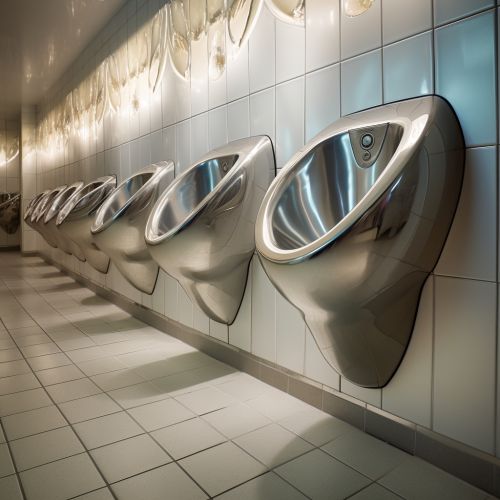Waterless urinal
Introduction
A waterless urinal is a type of urinal that does not use water for flushing. Instead, it employs a variety of methods to control odors and maintain hygiene. This technology has been around since the late 19th century, but it has gained popularity in recent years due to its environmental benefits and cost-effectiveness.


History
The first patent for a waterless urinal system was granted in the United States in 1886. However, the technology did not gain widespread acceptance until the late 20th century, when concerns about water conservation and sustainability became more prominent. The first modern waterless urinal was introduced by the company Falcon Waterfree Technologies in 1991.
Design and Operation
Waterless urinals can be made from a variety of materials, including porcelain, stainless steel, and plastic. They are designed to be easy to clean and maintain, with a smooth, non-porous surface that prevents the growth of bacteria and other microorganisms.
The key component of a waterless urinal is the urinal deodorizer block or cartridge, which is placed in the base of the urinal. This block contains a sealant liquid that is lighter than urine. When urine enters the urinal, it passes through the sealant liquid and is trapped underneath it, preventing odors from escaping into the air. The urine then drains into the sewer system through a one-way valve, which also helps to prevent odors from escaping.
Some waterless urinals also use a biodegradable sealant liquid that breaks down urine into harmless by-products, further reducing odors and the need for cleaning. Others use a microbial coating that breaks down urine and prevents the growth of bacteria.
Advantages
Waterless urinals offer several advantages over traditional, water-flushing urinals. The most obvious benefit is the conservation of water. A typical water-flushing urinal uses between 1 and 3 gallons of water per flush, while a waterless urinal uses no water at all. This can result in significant water savings, especially in large facilities or areas with high water costs.
In addition to water conservation, waterless urinals also offer cost savings. They require less maintenance than traditional urinals, as there are no moving parts to break or wear out. They also eliminate the need for flush valves, which can be expensive to replace.
Waterless urinals can also improve indoor air quality by reducing odors. The sealant liquid in the urinal deodorizer block traps odors, preventing them from escaping into the air. This can make restrooms more pleasant and comfortable for users.
Disadvantages
Despite their advantages, waterless urinals also have some disadvantages. One of the main concerns is the cost of the urinal deodorizer blocks or cartridges. These need to be replaced regularly, which can be expensive over time.
Another concern is the potential for odors if the urinal is not properly maintained. If the sealant liquid is not replaced regularly, or if the urinal is not cleaned regularly, odors can escape into the air.
Some people also have concerns about the hygiene of waterless urinals. While the smooth, non-porous surface of the urinal is designed to prevent the growth of bacteria, some people worry that the lack of flushing water could lead to a buildup of bacteria or other microorganisms. However, studies have shown that waterless urinals are no less hygienic than traditional urinals.
Environmental Impact
Waterless urinals can have a significant positive impact on the environment. By eliminating the need for flushing water, they can save thousands of gallons of water per year. This can reduce the demand on water treatment facilities and decrease the amount of wastewater that needs to be treated and discharged into the environment.
In addition, waterless urinals can reduce energy use. The production and treatment of water requires energy, so by reducing water use, waterless urinals can also reduce energy consumption.
Conclusion
Waterless urinals are an innovative technology that can save water, reduce costs, and improve indoor air quality. While they do have some disadvantages, these can be mitigated with proper maintenance and care. As concerns about water conservation and sustainability continue to grow, it is likely that the use of waterless urinals will continue to increase.
